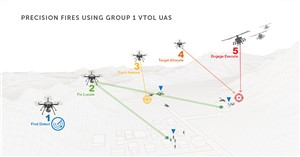The Proliferation of Precision Fires
September 27, 2022
-In a new whitepaper, Teledyne FLIR Defense, part of Teledyne Technologies Incorporated (NYSE:TDY), explores the critical importance of precision fires to address capability gaps on the battlefield and engage a new generation of enemy threats. The whitepaper also examines game-changing Laser Target Designator (LTD) technology employed by Group 1 small Unmanned Aircraft Systems (sUAS) that can resolve operating constraints, speed decision-making, and boost the mission success of precision strikes.
The paper, ‘The Proliferation of Precision Fires,’ discusses how every warfighter on the battlefield benefits from technology that enables them to call for fires anytime and in any environment. Precision fires rely upon the accurate delivery of precision guided munitions onto targets using a variety of methods. Options include laser or Global Positioning System (GPS) guidance systems as well as inertial navigation units embedded into the munition, any of which help deliver an effect to within several meters of a target, even at extended ranges.
The strategic importance of precision fires continues to be underlined by the ongoing war in Ukraine. Ukrainian Armed Forces have successfully deployed precision fires to destroy Russian positions and materiel while minimizing collateral damage to civilian populations and critical infrastructure.
“Warfighters face a new generation of threats on today’s battlefield that require new capabilities to ensure ‘overmatch’ against near-peer adversaries,” said Dr. JihFen Lei, executive vice president and general manager of Teledyne FLIR Defense. “The ability to call and direct fires anytime, anywhere is crucial, and our whitepaper explores advanced laser target designator technologies that can enhance the effectiveness of precision fires.
“Recent advancements will enable units operating at the lowest tactical level to quickly setup a small UAS; attach an LTD; and then launch, find, and designate targets for laser-guided munitions from safer, stand-off positions,” Lei added.
Key findings include:
- Heavily relied upon during counter-insurgency campaigns of the last two decades, precision fires are re-emerging as a significant enabler for modern armed forces operating against near-peer adversaries in the age of strategic competition.
- The proliferation of precision fires is clear to see within the U.S. Dept. of Defense alone, which appropriated 39,500 munitions in FY2021 with a further 16,700 requested in FY2022. Long Range Precision Fires is the U.S. Army’s top modernization priority while, similarly, Organic Precision Fires (OPF) is part of the U.S. Marine Corps’ Force Design 2030 strategy.
- Warfighters on the ground operating LTDs face tactical challenges that include inaccessibility; size, weight and power (SWaP) limitations; austere environments; and time limitations.
- Reduced SWaP LTDs can now be integrated on board Group 1 Vertical Takeoff/Landing (VTOL) sUAS, providing precision fires to the lowest tactical level and reducing targeting cycles from minutes to just seconds.
- Upgraded LTDs not only maximize mission effectiveness of units at the tactical edge, but also extend use cases to include border security, vehicle interdiction, and maritime/coastal applications.
- A close companion of the LTD is the Laser Spot Tracker (LST). LST allows operators to see other platforms’ laser spots, enabling them to verify and correct spots from multiple sources. LST helps units orchestrate their mission by coordinating the various laser designating platforms, improving attack efficiency and effectiveness.
The paper concludes with a quote from U.S. Army Chief of Staff, General James McConville, who sums up the goals of the Pentagon’s approach to precision fires: “We don’t want to be indiscriminate when we conduct precision strikes and as we move to the future, we’re going to be using all types of sensors. We are going to have a lot of capability for long range fires and having people on the battlefield who can do that is going to be very important.”
Source : Teledyne FLIR LLC

Related Studies


